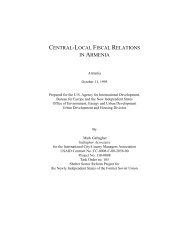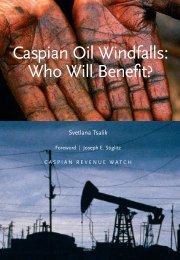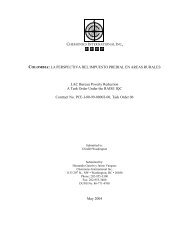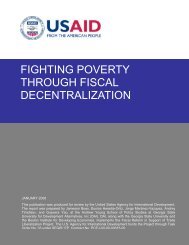Effectiveness and Economic Impact of Tax Incentives in the SADC ...
Effectiveness and Economic Impact of Tax Incentives in the SADC ...
Effectiveness and Economic Impact of Tax Incentives in the SADC ...
Create successful ePaper yourself
Turn your PDF publications into a flip-book with our unique Google optimized e-Paper software.
TAXATION, INVESTMENT, AND GROWTH 2-3<br />
countries should be <strong>in</strong> a position to achieve high rates <strong>of</strong> growth— as evidenced by more than<br />
a few remarkable success stories over <strong>the</strong> past 40 years. 11<br />
The immediate implication is that a successful growth strategy must be seriously concerned<br />
with <strong>the</strong> impact <strong>of</strong> policies on productivity, <strong>in</strong>novation, <strong>and</strong> knowledge acquisition.<br />
Investment <strong>in</strong> physical capital is one determ<strong>in</strong>ant <strong>of</strong> economic growth, but not <strong>the</strong> most<br />
important one. This is why Easterly <strong>and</strong> Lev<strong>in</strong>e, <strong>in</strong> <strong>the</strong> passage quoted at <strong>the</strong> beg<strong>in</strong>n<strong>in</strong>g <strong>of</strong> this<br />
chapter, emphasize that “someth<strong>in</strong>g else” beyond capital accumulation accounts for most <strong>of</strong><br />
<strong>the</strong> differences <strong>in</strong> economic growth across countries. Similarly, Michael Porter’s <strong>in</strong>fluential<br />
<strong>the</strong>ory <strong>of</strong> competitiveness highlights <strong>the</strong> importance <strong>of</strong> productivity. Accord<strong>in</strong>g to Porter,<br />
policies foster<strong>in</strong>g <strong>in</strong>vestments that depend on cont<strong>in</strong>ued subsidies or protection are “simply<br />
<strong>in</strong>appropriate… no matter what <strong>the</strong> stage <strong>of</strong> development <strong>of</strong> a nation’s <strong>in</strong>dustry.” (Porter<br />
1998, 674.) Even more sharply, Devarajan, Easterly <strong>and</strong> Pack (2002) provide evidence show<strong>in</strong>g<br />
that “<strong>in</strong>vestment is not <strong>the</strong> constra<strong>in</strong>t on African development.” Their empirical analysis<br />
<strong>in</strong>dicates that low growth rates <strong>in</strong> Africa are primarily due to low <strong>and</strong> decl<strong>in</strong><strong>in</strong>g productivity<br />
result<strong>in</strong>g from policies that foster <strong>and</strong> susta<strong>in</strong> <strong>in</strong>efficient production activities. In short,<br />
neglect <strong>of</strong> <strong>the</strong> productivity component <strong>in</strong> <strong>the</strong> growth equation can totally underm<strong>in</strong>e <strong>the</strong><br />
benefit <strong>of</strong> higher <strong>in</strong>vestment <strong>and</strong> impair <strong>the</strong> quest for prosperity. 12<br />
Exhibit 2-1 outl<strong>in</strong>es policies that help foster productivity. One <strong>of</strong> <strong>the</strong>m is <strong>the</strong> use <strong>of</strong> tax<br />
<strong>in</strong>centives to encourage efficient <strong>in</strong>vestment, tra<strong>in</strong><strong>in</strong>g, <strong>and</strong> research <strong>and</strong> development. The<br />
impact <strong>of</strong> <strong>in</strong>vestment tax <strong>in</strong>centives on efficiency will be exam<strong>in</strong>ed <strong>in</strong> more detail <strong>in</strong> <strong>the</strong><br />
follow<strong>in</strong>g chapter. But first let us exam<strong>in</strong>e <strong>in</strong> general terms <strong>the</strong> <strong>in</strong>fluence <strong>of</strong> tax policy on<br />
<strong>in</strong>vestment decisions.<br />
2.2 Theory <strong>of</strong> <strong>the</strong> Determ<strong>in</strong>ants <strong>of</strong> Investment<br />
RISK AND RETURN<br />
The driv<strong>in</strong>g force beh<strong>in</strong>d private <strong>in</strong>vestment can be conceptualized <strong>in</strong> terms <strong>of</strong> risk <strong>and</strong><br />
return. Investment projects are viable when <strong>the</strong> expected rate <strong>of</strong> return on capital exceeds a<br />
threshold (hurdle) rate that reflects <strong>the</strong> cost <strong>of</strong> capital plus a premium to compensate for<br />
perceived risk. If two mutually exclusive alternatives are both viable—for example, two<br />
11 Examples <strong>in</strong>clude Korea, Taiwan, Malaysia, Indonesia, Ch<strong>in</strong>a, Botswana, Mauritius, Chile, <strong>and</strong> more<br />
recently, Vietnam <strong>and</strong> India. All <strong>of</strong> <strong>the</strong>se countries have achieved susta<strong>in</strong>ed periods <strong>of</strong> growth <strong>and</strong> poverty<br />
reduction at rates far higher than today’s rich countries experienced historically.<br />
12 Moran (1998) found that nearly half <strong>of</strong> <strong>the</strong> FDI projects that he exam<strong>in</strong>ed <strong>in</strong> 30 countries had net negative<br />
effects on host-country welfare. Pigato (2000) reviews several such studies <strong>and</strong> concludes that negative effects<br />
<strong>of</strong> FDI arise ma<strong>in</strong>ly from “lack <strong>of</strong> competitiveness <strong>of</strong> <strong>in</strong>put <strong>and</strong> output markets <strong>in</strong> <strong>the</strong> host country, <strong>and</strong> from<br />
distortions <strong>in</strong> <strong>the</strong> domestic <strong>in</strong>centive framework.”











